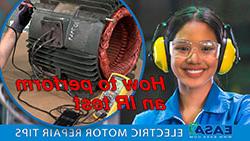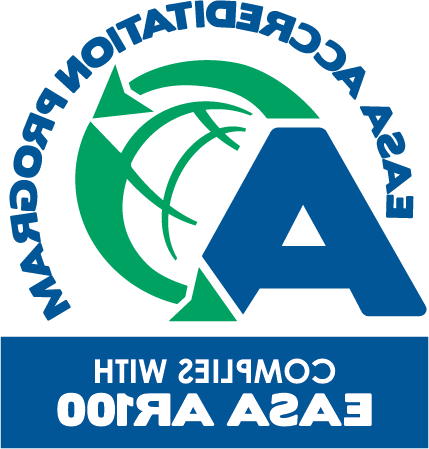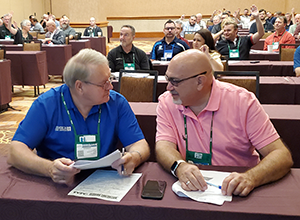What Membership Provides
Join EASA and gain access to unparalleled expertise and information focused on helping your company — and the entire electromechanical sales, service and repair industry — succeed.
The Benefits of Belonging
Access to Engineering Support
Access to EASA's engineering staff ensures members receive expert guidance on complex technical issues, fostering confidence in their solutions. EASA's engineering team is highly regarded and highly active in the industry as well as its standards and governing organizations.
EASA's staff of engineers can provide technical and engineering consultation, support and design work for electo-mechanical equipment, including:
- AC and DC electric motors
- Motor winding connection verifications
- Motor redesigns - concentric-to-lap, lap-to-concentric, pole changes, connection changes, and more
- Research of motor winding data
- Motor systems and application guidance
- Synchronous machines
- Pumps
- Transformers
- Gearboxes
- Drives and electronic controls
- Motor and industry standards
- And more ...
EASA also employs a dedicated pump & vibration specialist to assist you with machine balancing and vibration troubleshooting, as well as helping design or troubleshoot pump-related systems.
| Access technical support via ... | |||
Website |
Phone |
Fax |
|
| This team is able to assist you in both English and Español! | |||
Technical Resources
 Technical content and training is where EASA excels. Your membership provides access to a variety of resources that help grow the technical side of your business. From novices to experienced technicians, there is something for everyone.
Technical content and training is where EASA excels. Your membership provides access to a variety of resources that help grow the technical side of your business. From novices to experienced technicians, there is something for everyone.
- Access to EASA's engineering team.
- Access to technical articles delivered each month as part of EASA's newsletter, Currents.
- FREE access to the downloadable, 900+ page EASA Technical Manual, or discounted pricing for a printed copy.
- FREE access to EASA's Motor Winding Data with winding data for 250,000+ motors.
- Ability to purchase EASA's AC Motor Verification & Redesign software.
- Access to EASA's growing library of online motor calculators.
- Access to EASA's Resource Library, an online repository containing more than 925+ entries.
- Discounted subscriptions to the EASA Learning Center, 24/7/365 industry-specific training
- Discounted pricing to the Electromechanical Repair Technician (ERT) Certificate Program.
- FREE monthly webinars, most of which focus on a different technical topic.
- And much more ...
Exclusive Software
EASA offers exclusive member tools like the AC Motor Verification and Redesign software as well as our Motor Rewind Data plus unlimited access to our experienced engineering staff, which are vital for our members. The AC Motor Verification and Redesign program is fully integrated with EASA's Motor Rewind Database of more than 250,000 motor winding designs. This makes it the perfect program to lookup motor data, to verify existing winding data, and to perform motor winding redesigns.
EASA also has a growing list of FREE online motor calculators.
- Balance Grade Quality
- Coil Grouping
- Locked Rotor Test
- Loop Test
- Secondary Voltage
- Small Motor Performance
- Three-Phase Lead Wire Sizing
- Vibration Unit Converter
- Wire Package
These resources not only improve operational performance but also drive innovation and excellence in the industry. EASA's commitment to supporting its members with these tools highlights its dedication to their success and growth.
Training & Events
EASA prepares our members for the future through our exceptional training and events. EASA offers comprehensive education programs, including webinars, seminars, workshops, and online training programs. We ensure members stay ahead of industry advancements.
Training covers critical topics such as repair procedures, motor design, emerging technologies, safety, best practices and more. Events like our industry leading convention and expo, provide invaluable networking opportunities, allowing members to connect with industry experts and peers, fostering collaboration and innovation.
EASA’s 24 chapters let our members connect and share ideas at the local events near them all over the world. By equipping members with cutting-edge knowledge and skills, EASA ensures they are well-prepared to tackle future challenges and drive progress in the electrical apparatus industry.
TRAINING OPTIONS EASA LEARNING CENTER ERT CERTIFICATE PROGRAM
Business Development & Marketing Tools
Look to EASA for tools to help you grow and manage your business. From marketing support to connection opportunities, leverage these resources to position yourself for continued success.
- Exclusive industry research.
- Monthly articles on management, marketing, sales or safety.
- Women of EASA networking group.
- Roving Chief Executives networking program.
- Resources specifically for your customers.
- Discounted pricing for the EASA Learning Center.
24/7/365 online training covering technical, management, sales, human resources and safety topics - Discounted pricing for EASA's Annual Convention & Solutions Expo.
Four days that include education, networking opportunities and exploration of the latest industry offerings in the Solutions Expo. - Networking opportunities with other business leaders in your area through EASA Chapter and Regional events.
- Discounts on promotional materials and custom branded items.
Industry Representation
EASA’s staff and volunteer committee members represent our interests on numerous standards-making committees, ensuring our industry's voice is heard. EASA's involvement with these esteemed organizations is crucial. Our active participation ensures that industry standards reflect our members' needs, promote safety, drive innovation, and uphold quality. By advocating on these influential committees, EASA helps shape a prosperous and sustainable future for the electrical apparatus industry.
By joining EASA, you'll be ensuring your voice is heard within these groups.
Acoustical Society of America (ASA)
Gene Vogel, EASA Pump & Vibration Specialist
- ASA ASC-S2 Work Group 15 - Shaft Alignment Methodology (acting chair)
Canadian Standards Association (CSA)
Tom Bishop, PE, EASA Senior Technical Support Specialist
- CSA 392 Subcommittee on Motor Refurbishment, Testing of three-phase cage induction motors during refurbishment
European Committee of Manufacturers of Electrical Machines and Power Electronics (CEMEP)
Frederic Beghain, EASA Region 9 General Manager
International Electrotechnical Commission (IEC)
John Allen, Sheppard Engineering Limited
- Working Group for Introduction of IEC 60079-19 into IEC Ex Scheme
- TC31 Management Committee for IEC 60079-19
Tom Bishop, PE, EASA Senior Technical Support Specialist
- Maintenance Team 60079-1 for IEC 60079-1, Electrical Apparatus for Explosive Gas Atmospheres
- TC31 US TAG for IEC 60079, 61779, 62013 and 62086
Mike Howell, PE, EASA Technical Support Specialist
- USNC TAG for IEC SC22G, Adjustable Speed Electric Drive Systems Incorporating Semiconductor Power Converters
Chuck Yung, EASA Senior Technical Support Specialist
- TC2 working group
- IEC 60034-8 Rotating Electrical Machines; Terminal Markings
- IEC 60034-11 Rotating electrical machines – thermal protection
- IEC 60034-17 Motors fed from converters
- IEC 60035-2-34 Standards Technical Panel for Hermetic Refrigerant Motor-Compressors
- IEC 60034-27 Rotating electrical machines – Part 27: Partial discharge off-line measurements on the stator winding insulation of rotating machinery
Institute of Electrical and Electronics Engineers (IEEE)
Chuck Yung, EASA Senior Technical Support Specialist
- IEEE 115 Test Procedures for Synchronous Machines
- IEEE 303 Recommended Practice for Auxiliary Devices for Rotating Electrical Machines in Class I, Division 2 and Zone 2 Locations and Class II, Division 2 and Zone 22 Locations
- IEEE 841-1 (North America) & 841-2 (International) Standard for the Petroleum and Chemical Industry - Severe Duty Totally Enclosed Fan-Cooled (TEFC) Electric Motors
- IEEE 1017-2013 Recommended Practice for Field Testing Electrical Submersible Cable
- IEEE 1018 Recommended Practice for Specifying Electric Submersible Pump Cable - Ethylene Propylene Rubber Insulation
- IEEE 1019 Recommended Practice for Specifying Electric Submersible Pump Cable - Polypropylene Insulation
- IEEE 1068 Standard for the Repair and Rewinding of Electric Motors for the Petrochemical and Other Process Industries (chair)
- IEEE 1349 Motors in Hazardous Locations
- IEEE 1458 Recommended Practice for the Selection, Field Testing and Life Expectancy of Molded Case Circuit Breakers for Industrial Applications
- IEEE 1566 Standard for Performance of Adjustable Speed AC Drives Rated 375 kW and Larger
- IEEE 1584 Guide for Performing Arc-Flash Hazard Calculations
- IEEE 1683 Guide for Motor Control Centers Rated Up to and Including 600v AC or 1000v DC with Recommendations Intended to Help Reduce Electrical Hazards
- IEEE 1716 Recommended Practice for Managing Natural Disaster Impact of Key Electrical Systems and Installations in Petroleum and Chemical Facilities
- IEEE 1814 Recommended Practice for Electrical System Design Techniques to Improve Electrical Safety
- IEEE 2455 Repair Guide for DC Machines (chair)
Mike Howell, PE, EASA Technical Support Specialist
- IEEE P114 Standard Test Procedure for Single-Phase Induction Motors
- IEEE 1415 Guide for Induction Machinery Maintenance Testing
- IEEE Standard 11-2006, Rotating Electric Machinery for Rail and Road Vehicles
IEEE Standards Association—Standards Review and Ballot
Tom Bishop, PE, EASA Senior Technical Support Specialist
- IEEE C37.102 Guide for AC Generator Protection
- IEEE C57.12.00 Standard for the General Requirements for Liquid-Immersed Distribution, Power, and Regulating Transformers
- IEEE C57.12.90 Standard Test Code for Liquid-Immersed Distribution, Power, and Regulating Transformers
- IEEE C57.94 Recommended Practice for Installation, Application, Operation, and Maintenance of Dry-Type Distribution and Power Transformers
- IEEE 56 Guide for Insulation Maintenance of Electric Machines (Combines IEEE 56 and IEEE 432)
- IEEE 95 Recommended Practice for Insulation Testing of AC Electric Machinery with High Direct Voltage
- IEEE 112 Test Procedure for Polyphase Induction Motors and Generators
- IEEE 117 Standard Test Procedure for Thermal Evaluation of Systems of Insulating Materials for Random-Wound AC Electric Machinery
- IEEE 286 Recommended Practice for Measurement of Power Factor Tip-Up of Electric Machinery Stator Coil Insulation
- IEEE 1665 Guide for the Rewind of Synchronous Generators, 50 Hz and 60 Hz, Rated 1 MVA and Above
- IEEE 1812 Guide for Testing Permanent Magnet Machines
- IEEE 3002.7 Recommended Practice for Conducting Motor-Starting Studies in Industrial and Commercial Power Systems
- IEEE 3002.8 Recommended Practice for Conducting Harmonic-Analysis Studies of Industrial and Commercial Power Systems
Green Motors Practices Group
Linda Raynes, EASA President and CEO
Tom Bishop, PE, EASA Senior Technical Support Specialist
National Electrical Manufacturers Association (NEMA)
Chuck Yung, EASA Senior Technical Support Specialist
- ANSI C50 Rotating Machinery Committee (Alternate: Tom Bishop, P.E., EASA Senior Technical Support Specialist)
Tom Bishop, PE, EASA Senior Technical Support Specialist
- NEMA Codes and Standards (C&S) Task Force on Refurbishing Products
Mike Howell, PE, EASA Technical Support Specialist
- NEMA MW 1000
National Fire Protection Association (NFPA)
Tom Bishop, PE, EASA Senior Technical Support Specialist
- NFPA 70B Electrical Equipment Maintenance
Underwriters Laboratories (UL)
Tom Bishop, PE, EASA Senior Technical Support Specialist
- 506 Low Voltage Transformers
- 1004 Standard for Electric Motors (7 sub-categories)
- 1446 Systems of Insulating Materials
- 1562 Transformers, Distribution, Dry-Type over 600 volts
- 2111 Standard for Overheating Protection for Motors
Chuck Yung, EASA Senior Technical Support Specialist
- 448 Standard for Pumps for Fire Protection Service
- 674 Electric Motors and Generators for Hazardous Locations
- 778 Standard for Motor-Operated Water Pumps
- 840 Standard for Insulation Coordination Including Clearances and Creepage Distances for Electrical Equipment
- 1434 Standard for Thermistor-Type Devices
- 1450 Standard for Motor-Operated Air Compressors, Vacuum Pumps and Painting Equipment
Vibration Institute
Gene Vogel, EASA Pump & Vibration Specialist
- ANSI-ASA_S2-WG15 Committee for Shaft Alignment Standards (co-chair)
Exclusive Member Discount Programs
EASA offers exclusive member discounts to Service First Processing and Estes Express Lines, significantly saving members money. These discounts lower transaction processing fees and shipping costs, directly benefiting the bottom line. Service First Processing ensures affordable and efficient payment solutions, while Estes Express Lines provides reliable and cost-effective shipping services. By leveraging these discounts, members can reduce operational expenses and enhance profitability. EASA's commitment to offering these exclusive benefits underscores its dedication to supporting members' financial health, enabling them to reinvest savings into their businesses and drive further growth and success.
 |
 |
News & Information
 EASA provides up-to-date technical knowledge, industry trends, and best practices, ensuring members stay informed and competitive. The association's commitment to education through webinars, seminars, and our monthly magazine, Currents, equips professionals with the skills needed to excel.
EASA provides up-to-date technical knowledge, industry trends, and best practices, ensuring members stay informed and competitive. The association's commitment to education through webinars, seminars, and our monthly magazine, Currents, equips professionals with the skills needed to excel.
Moreover, EASA's network fosters collaboration and knowledge sharing among industry leaders. By consistently delivering reliable and relevant information, EASA empowers its members to make informed decisions, drive innovation, and maintain high standards in the electrical apparatus industry.
Shaping the Industry Through EASA'S Committees

EASA empowers its members to shape the industry by serving on its committees. Members who participate can directly influence standards, policies, and educational programs, ensuring they align with current needs and future trends. Committee service fosters collaboration among industry experts, drives innovation, and enhances professional growth. By contributing their expertise, members help address critical issues, advocate for industry interests, and promote best practices. This active involvement not only strengthens the EASA community but also ensures a forward-thinking, resilient, and competitive industry. Serving on a committee is a unique opportunity to make a lasting impact.

 Having trouble finding time for training? Check out the how-to videos in EASA’s new series Electric Motor Repair Tips.
Having trouble finding time for training? Check out the how-to videos in EASA’s new series Electric Motor Repair Tips.








